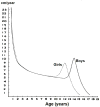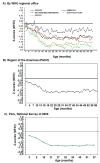Improved nutrition in the first 1000 days and adult human capital and health
- PMID: 28117514
- PMCID: PMC5761352
- DOI: 10.1002/ajhb.22952
Improved nutrition in the first 1000 days and adult human capital and health
Abstract
Objective: The aim of this article is to review why the first 1000 days of life are a vulnerable period of human development and the long-term effects of a nutrition experiment carried out in Guatemala (1969-1977).
Methods: In 1969-77, a supplement called Atole, containing high quality protein, energy and micronutrients, was provided to women during pregnancy and lactation and to children <7 years of age in two villages while in two control villages a low-energy drink called Fresco was provided. The villages were assigned at random to the treatment groups.
Results: Several reasons explain the vulnerability of the first 1000 days: rapid growth and development, high nutritional requirements, greater susceptibility to infections, high sensitivity to programming effects and full dependence on others for care, nutrition, and social interaction. Compared with Fresco, Atole improved total nutrient intakes (protein, energy, and micronutrients) and reduced stunting, but only in children < 3 years of age. A study in 2002-2004 showed that schooling, reading, and intelligence were improved in Atole villages, but only in those who received Atole before the age of 3 years. Wages of men were increased by 46% in those provided Atole through the age of 2 years. Findings for cardiovascular disease risk factors were inconclusive, perhaps because of the young age of the sample. A new study focusing on chronic diseases is ongoing (ages 38-54 years).
Conclusions: The Guatemalan studies indicate that substantial improvement in adult human capital and economic productivity resulted from the nutrition intervention. This provides a powerful argument for promoting improvements in nutrition in pregnant women and young children in low income countries.
© 2017 Wiley Periodicals, Inc.
Figures








References
-
- Adair LS, Fall CH, Osmond C, Stein AD, Martorell R, Ramirez-Zea M, Sachdev HS, Dahly DL, Bas I, Norris S, Micklesfield L, Hallal P, Victora C, for the COHORTS Group Associations of linear growth and relative weight gain during early life with adult health and human capital in countries of low and middle income: findings from five birthcohort studies. The Lancet. 2013;382(9891):525–34. - PMC - PubMed
-
- Behrman J, Hoddinott, Maluccio JA, Martorell R. Brains versus Brawn: Labor Market Returns to Intellectual and Physical Health Human Capital in a Developing Country. Mimeo, International Food Policy Research Institute; Washington, DC: 2010. p. 38. [ http://dx.doi.org/10.2139/ssrn.1471316] - DOI
-
- Bhutta ZA, Das JK, Arjumand R, Gaffey MF, Walker N, Horton S, Webb P, Lartey A, Black RE, The Lancet Nutrition Interventions Review Group, and The Maternal and Child Nutrition Study Group Evidence-based interventions for improvement of maternal and child nutrition: what can be done and at what cost? The Lancet. 2013;382(9890):452–77. - PubMed
-
- Black RE, Victoria CG, Walker SP, Bhutta ZA, Christian P, de Onis M, Ezzati M, Grantham-McGregor S, Katz J, Martorell R, Uauy R, Maternal and Child Nutrition Study Group Maternal and child undernutrition and overweight in low-income and middle-income countries. The Lancet. 2013;382(9890):427–451. - PubMed
-
- Casey BJ, Tottenham N, Liston C, Durston S. Imaging the developing brain: what have we learned about cognitive development? Trends in Cognitive Sciences. 2005;9:104–110. - PubMed
MeSH terms
Grants and funding
LinkOut - more resources
Full Text Sources
Other Literature Sources
Medical

